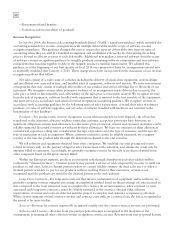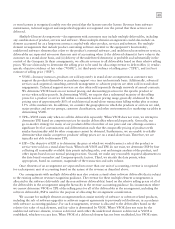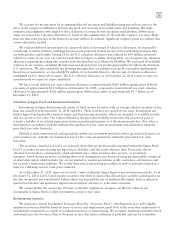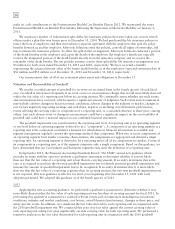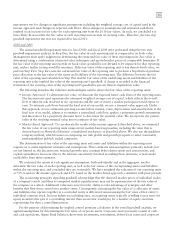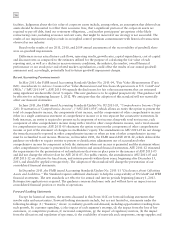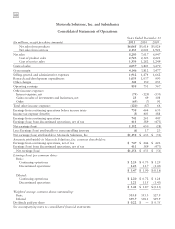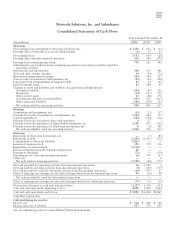Motorola 2011 Annual Report Download - page 62
Download and view the complete annual report
Please find page 62 of the 2011 Motorola annual report below. You can navigate through the pages in the report by either clicking on the pages listed below, or by using the keyword search tool below to find specific information within the annual report.
56
facilities. Judgments about the fair value of corporate assets include, among others, an assumption that deferred tax
assets should be discounted to reflect their economic lives, that a significant portion of the corporate assets are
required to pay off debt, fund our retirement obligations, , and market participants’ perceptions of the likely
restructuring costs, including severance and exit costs, that might be incurred if our strategy is not successful. The
results of our impairment analysis result in an implied control premium commensurate with historical transactions
observed in our industry.
Based on the results of our 2011, 2010, and 2009 annual assessments of the recoverability of goodwill, there
were no goodwill impairments.
Differences in our actual future cash flows, operating results, growth rates, capital expenditures, cost of capital
and discount rates as compared to the estimates utilized for the purpose of calculating the fair value of each
reporting unit, as well as a decline in macroeconomic conditions, the industry, the market, overall financial
performance or our stock price and related market capitalization, could affect the results of our annual goodwill
assessment and, accordingly, potentially lead to future goodwill impairment charges.
Recent Accounting Pronouncements
In May 2011, the FASB issued Accounting Standards Update No. 2011-04, “Fair Value Measurements (Topic
820): Amendments to Achieve Common Fair Value Measurement and Disclosure Requirements in U.S. GAAP and
IFRSs,” (“ASU 2011-04”). ASU 2011-04 expands the disclosures for fair value measurements that are estimated
using significant unobservable (Level 3) inputs. This new guidance is to be applied prospectively. This guidance will
be effective for us beginning January 1, 2012. We anticipate that the adoption of this standard will not materially
affect our financial statements.
In June 2011, the FASB issued Accounting Standards Update No. SU 2011-05, “Comprehensive Income (Topic
220): Presentation of Comprehensive Income”, (“ASU 2011-054”) which allows an entity the option to present the
total of comprehensive income, the components of net income, and the components of other comprehensive income
either in a single continuous statement of comprehensive income or in two separate but consecutive statements. In
both instances, an entity is required to present each component of net income along with total net income, each
component of other comprehensive income along with a total for other comprehensive income, and a total amount
for comprehensive income. ASU 2011-05 eliminates the option to present the components of other comprehensive
income as part of the statement of changes in stockholders’ equity. The amendments in ASU 2011-05 do not change
the items that must be reported in other comprehensive income or when an item of other comprehensive income
must be reclassified to net income. However, in December 2011, the FASB issued ASU 2011-12, which deferred the
guidance on whether to require entities to present reclassification adjustments out of accumulated other
comprehensive income by component in both the statement where net income is presented and the statement where
other comprehensive income is presented for both interim and annual financial statements. ASU 2011-12 reinstated
the requirements for the presentation of reclassifications that were in place prior to the issuance of ASU 2011-05
and did not change the effective date for ASU 2011-05. For public entities, the amendments in ASU 2011-05 and
ASU 2011-12 are effective for fiscal years, and interim periods within those years, beginning after December 15,
2011, and should be applied retrospectively. The adoption of this standard will change the presentation of our
consolidated financial statements.
In December 2011, the FASB issued Accounting Standards Update No. 2011-11 “Disclosures about Offsetting
Assets and Liabilities.” The Standard requires additional disclosure to help the comparability of US GAAP and IFRS
financial statements. The new standards are effective for annual and interim periods beginning January 1, 2013.
Retrospective application is required. The guidance concerns disclosure only and will not have an impact on our
consolidated financial position or results of operations.
Forward-Looking Statements
Except for historical matters, the matters discussed in this Form 10-K are forward-looking statements that
involve risks and uncertainties. Forward-looking statements include, but are not limited to, statements under the
following headings: (1) “Business,” about: (a) industry growth and demand, including opportunities resulting from
such growth, (b) customer spending, (c) the impact of each segment’s strategy, (d) the impact from the loss of key
customers, (e) competitive position, (f) increased competition, (g) the impact of regulatory matters, (h) the impact
from the allocation and regulation of spectrum, (i) the availability of materials and components, energy supplies and




